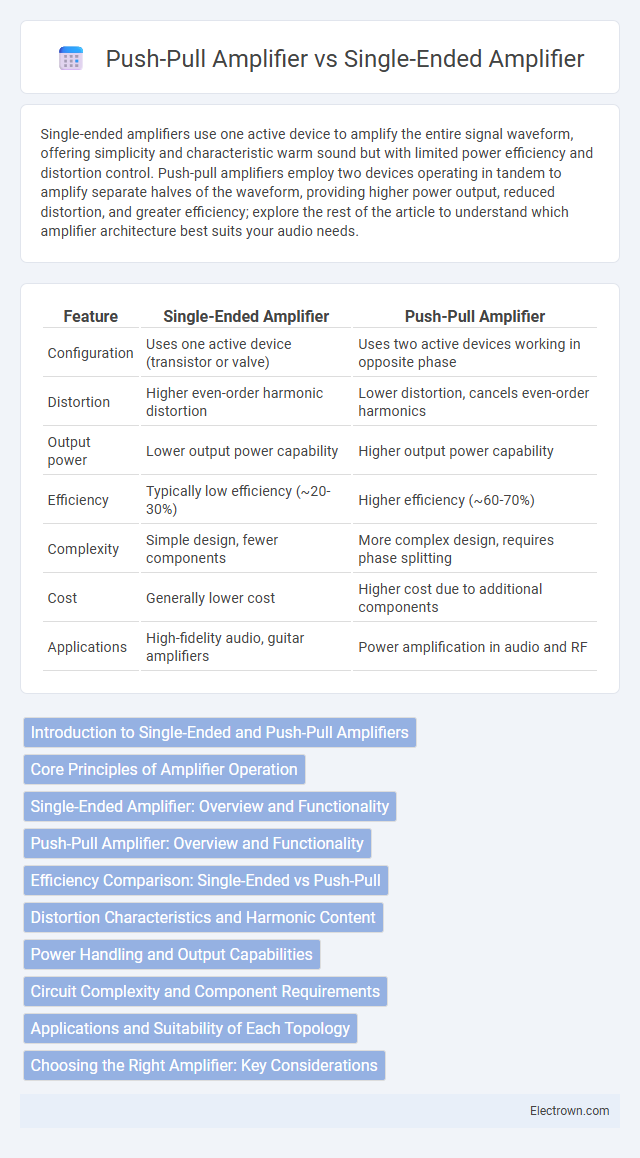Single-ended amplifiers use one active device to amplify the entire signal waveform, offering simplicity and characteristic warm sound but with limited power efficiency and distortion control. Push-pull amplifiers employ two devices operating in tandem to amplify separate halves of the waveform, providing higher power output, reduced distortion, and greater efficiency; explore the rest of the article to understand which amplifier architecture best suits your audio needs.
Table of Comparison
| Feature | Single-Ended Amplifier | Push-Pull Amplifier |
|---|---|---|
| Configuration | Uses one active device (transistor or valve) | Uses two active devices working in opposite phase |
| Distortion | Higher even-order harmonic distortion | Lower distortion, cancels even-order harmonics |
| Output power | Lower output power capability | Higher output power capability |
| Efficiency | Typically low efficiency (~20-30%) | Higher efficiency (~60-70%) |
| Complexity | Simple design, fewer components | More complex design, requires phase splitting |
| Cost | Generally lower cost | Higher cost due to additional components |
| Applications | High-fidelity audio, guitar amplifiers | Power amplification in audio and RF |
Introduction to Single-Ended and Push-Pull Amplifiers
Single-ended amplifiers use a single transistor or tube to amplify the entire audio signal, often resulting in simpler design and characteristic harmonic distortion that audiophiles appreciate. Push-pull amplifiers employ two devices operating in opposite phases to cancel even-order harmonics, improving linearity and efficiency. Your choice between these amplifier types depends on factors like desired sound quality, power output, and distortion characteristics.
Core Principles of Amplifier Operation
Single-ended amplifiers operate by driving the load with a single active device, resulting in simpler circuitry but increased distortion due to even harmonic generation. Push-pull amplifiers employ two complementary devices operating in opposite phases to cancel out even-order harmonics, enhancing linearity and efficiency. The push-pull topology inherently reduces signal distortion and improves power output by utilizing both halves of the input waveform.
Single-Ended Amplifier: Overview and Functionality
Single-ended amplifiers operate using a single active device, such as a transistor or vacuum tube, amplifying the entire input signal waveform without phase splitting. Their simple design results in characteristic harmonic distortion, often producing a warm and musically pleasing sound favored in audio applications. You can rely on single-ended amplifiers for straightforward, linear amplification where sonic purity and tonal richness are prioritized.
Push-Pull Amplifier: Overview and Functionality
Push-pull amplifiers utilize two active devices that alternately amplify opposite halves of an input signal, effectively reducing distortion and improving efficiency compared to single-ended designs. By driving one transistor for the positive half-cycle and another for the negative half-cycle, push-pull configurations achieve higher power output and better linearity. This topology cancels even-order harmonic distortions, making it ideal for audio amplification and RF applications requiring clean, powerful signals.
Efficiency Comparison: Single-Ended vs Push-Pull
Push-pull amplifiers exhibit significantly higher efficiency compared to single-ended designs due to their ability to cancel even-order harmonics and operate with complementary transistors, leading to reduced power loss and heat dissipation. Single-ended amplifiers, while simpler and offering a unique harmonic distortion profile, generally waste more power as they conduct current continuously, limiting their efficiency to around 20-30%. Your choice between these amplifier types should consider the trade-off between sound characteristics and power efficiency, especially in applications where energy consumption and thermal management are critical.
Distortion Characteristics and Harmonic Content
Single-ended amplifiers exhibit higher levels of even-order harmonic distortion, which can produce a warm, musically pleasing sound that some audiophiles prefer. Push-pull amplifiers cancel out even-order harmonics due to their symmetrical design, resulting in lower overall distortion and a cleaner output with predominantly odd-order harmonics. Understanding these distortion characteristics can help you choose the amplifier type that best suits your audio preferences and listening environment.
Power Handling and Output Capabilities
Single-ended amplifiers typically handle lower power output, often limited to a few watts due to their design using a single active device conducting during the entire signal cycle. Push-pull amplifiers provide higher power handling and output capabilities by utilizing two active devices operating in complementary phases, which reduces distortion and allows greater efficiency. The push-pull configuration supports larger load driving and improved linearity, making it suitable for high-power audio applications.
Circuit Complexity and Component Requirements
Single-ended amplifiers feature simpler circuit designs with fewer components, typically requiring a single output device and fewer passive elements, which reduces cost and complexity. Push-pull amplifiers demand more complex circuitry, incorporating pairs of active devices such as transistors or tubes operating in opposing phases, along with additional components like phase splitters and transformers. The increased component count and circuit intricacy in push-pull designs enable improved efficiency and reduced distortion but require careful matching and biasing of components.
Applications and Suitability of Each Topology
Single-ended amplifiers are ideal for low-power audio applications and vintage-style tube amplifiers, providing warm, harmonic-rich sound suited for audiophiles and guitar amplifiers. Push-pull amplifiers offer higher power output with reduced distortion, making them suitable for professional audio systems, hi-fi stereo equipment, and radio frequency transmitters. Your choice depends on whether you prioritize harmonic texture and simplicity or efficiency and higher power performance in the amplification stage.
Choosing the Right Amplifier: Key Considerations
Selecting between single-ended and push-pull amplifiers hinges on factors like sound quality, efficiency, and distortion levels. Single-ended amplifiers offer warm, harmonically rich audio but tend to have higher distortion and lower power efficiency, making them ideal for audiophiles prioritizing tonal purity. Push-pull amplifiers deliver greater power output with reduced distortion and improved efficiency, suitable for applications where clean, high-fidelity sound is essential for your listening experience.
single-ended vs push-pull amplifier Infographic

 electrown.com
electrown.com